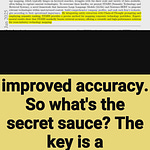This paper addresses the limitations of LLMs in abstract reasoning and long-form content generation due to their token-level processing. Large Concept Models (LCMs) are proposed as a solution.
→ This paper explains how Large Concept Models process semantic units instead of tokens to enhance reasoning and handle long contexts more effectively.
-----
https://arxiv.org/abs/2501.05487
📌 LCM's concept-level processing uses sentence embeddings. This contrasts with token-level models. It reduces sequence length. This inherently improves long-context handling and computational efficiency.
📌 Diffusion-based inference in LCM Core refines concept embeddings. This denoising process enhances output coherence. This contrasts with LLMs relying solely on Transformer architecture.
📌 SONAR embeddings enable LCM's multilingual and multimodal capabilities. This language-agnostic approach contrasts with LLMs. They typically require language-specific fine-tuning and tokenizers.
----------
Methods Explored in this Paper 🔧:
→ Large Concept Models process sentences as "concepts". These concepts are semantic units. This contrasts with LLMs, which process individual tokens.
→ LCM architecture includes three main components: Concept Encoder, LCM Core, and Concept Decoder.
→ The Concept Encoder converts input text or speech into language-agnostic concept embeddings using SONAR embeddings. It supports over 200 languages for text and 76 for speech in a unified embedding space.
→ The LCM Core uses diffusion-based inference to predict subsequent concepts. This core engine reasons over sequences of concept embeddings. It refines embeddings through a denoising process.
→ The Concept Decoder transforms concept embeddings back into text or speech. This ensures cross-modal consistency.
-----
Key Insights 💡:
→ LCMs perform hierarchical, concept-based reasoning. This is unlike LLMs' sequential, token-based reasoning.
→ LCMs offer inherent multilingual and multimodal support. They use language-agnostic embeddings. LLMs often require fine-tuning for new languages or modalities.
→ LCMs handle long contexts more efficiently. They process sentences instead of numerous tokens. LLMs face computational challenges with long sequences.
→ LCMs demonstrate strong zero-shot generalization. They can perform tasks across languages without retraining. LLMs may need fine-tuning for new tasks.
→ LCMs have a modular architecture. This allows for flexible extensions and updates. LLMs are typically monolithic and require extensive retraining for modifications.
-----
Results 📊:
→ LCMs support over 200 languages for text and 76 for speech via SONAR embeddings.
→ LCMs enhance multilingual NLP tasks without needing retraining across languages.
→ LCMs improve coherence in long-form content generation due to concept-level reasoning.









